Jones Island to Prevost Harbor, Stuart Island
We started today with the intention of finding the orcas. Once we made it out into Haro Strait we realized that the winds were very strong and that even if we found the orcas it would be very challenging to deploy the hydrophones. We made amazing time riding the tides and sailing at about 10 knots over ground, so we decided to circumnavigate San Juan Island. We got a lot of sailing in and made it up to Stuart Island around 4:30 and had a sailing lecture before finding out that J pod had been spotted heading north at Lime Kiln 1.5 hours prior. We decided to go out to the point to see if we could spot them as they passed by. We went out and at the tip of Turn Point there was a line of white water. It was the convergence zone of the upwellings caused by the tides moving over the rocks near the point. There was a mass of gulls all feeding in the upwellings. We went a bit further and saw some orcas. It was very exciting! We didn’t ID them because they were too far away and they weren’t on the surface in any predictable pattern. We thought that they were foraging so the direction they were moving was hard to tell, but we thought they were moving north.
Read More
Friday Harbor to Jones Island
We received a call today requesting assistance in the necropsy of another Steller sea lion. We met Joe at Orcas Island and made the short trip to the sea lion location. This was a lot like the last time, blunt trauma with severe bleeding in the abdominal region, heart, and lungs. The bruising of the tissues is something I have not experienced before, which was pretty neat. Jason and I met up with the rest of the crew in Friday Harbor, finalized packing the boat, and set our sights on Jones Island and the lovely Gato Verde. It feels good to be home on the boat. We had burrittos for the our first night of the first week at sea, and had to uphold the tradition again this first night. Hopefully the whales will join us tomorrow.
Read More
We arrived back on San Juan Islands three days ago. Looking back, it has been a very interesting week out at sea. My thoughts are sort of all over the place right now, because a lot certainly has happened this week, all accounted for in Nora’s blog if you were interested. But I shall share with you my highlights and thoughts about this past week.
I have to say, this is my first time officially boarding a boat and sailing out. I have only been on ferries and cruises, so I believe it does not count. On the 42 foot catamaran, Gato Verde, our captain Todd Shuster, welcomed us to the sailing world. From there, I learned how to navigate, read current maps, tie knots, drive the boat and tack when necessary, learn the names of boat parts, and anything boat related I could think about. It was quite a bit to handle if you think about it, waking up at 7 every morning and getting right to work. By the end of the day, we as a group would slouch down on the seats around the laden lamp. Personally, I felt exhausted after everyday, but that tiredness would always quickly shift to giddiness and excitement. I’m out on a boat, you know! I’m actually going to be on this boat, living on it and collecting data on wild orcas, which drives me to continue to work hard.
Speaking of orcas, we saw a couple of them on the first day on the boat, which entirely flipped my mind. It was in the midst of the chore rotations, that we all jumped when Kathryn yelled, “Whale!â€Â And what do you know? There were two groups of transient orcas swimming about to the starboard side. Immediately, I jumped up, super excited about the orca sightings, feeling like a little kid again. Todd quickly made a huge U-turn to follow the whales’ path. From there, I knew that we were not going to make it to Neah Bay, where we were originally planning on going to fix a broken hydrophone.
But I think we all made the best decision in following the whales instead of sticking to our plan. We chased them for a good six hours, constantly scanning the horizon for their dorsal fins with binoculars, while Nora and Kathryn would share the Beam Reach camera in hopes to ID the whales. We did get an ID on the male and a female: T87 (approx 1963) and T90B (2006), respectively. That said, there were a lot more whales than that. We saw about eight of them total. It made it really hard to count just because they kept taking longer dives. I guess that is what people say: transients are more difficult to follow and research since they are they ones that dive deeper and longer. They also spread out into a smaller amount of individuals per group, making it difficult to trace if they speed on ahead of the boat.

The most memorable things that happened were numerous. Firstly, a couple of orcas popped up from the water right behind the stern, startling us. I have to admit, I squealed with delight. They were so close, perhaps about three meters away from the boat. Todd shut off the motors instantaneously as we watched them swim by. I was too shocked and stunned to even lift my camera out to take a photo. It was absolutely gorgeous to experience a transient this close to us. Later on in the distance, we could see that the orcas were staying in the same area for a long time, erratically swimming in different directions and diving constantly. We suspected them to be foraging, or found something to eat perhaps. There were a ton of seagulls flying about, maybe looking for some meat scraps to pick off of. What topped it off though, was when, I peered through my binoculars, and one of the orcas performed a spyhop. Lastly, closer to the afternoon now, when two more whale watching boats joined us, we saw the group of female orcas out in the distance. They started to perform various surface active behaviors. They blew a couple of times out of the water, and then they started tail lobbing. That was really a sight to see, gazing at their tail flukes rising out of the water a couple of times. We also saw some tail slaps in the water.

That was probably the major highlight of the week. Other than that, we saw other wildlife as well. Tufted puffins, seals, river otters, and many seagulls as well. We have practiced a couple of times in deploying equipment and getting situated with using the sound recording devices. We now just have to wait for the southern residents to show up. I am thoroughly excited for the rest of the sea weeks to come. Who knows what wonders can happen when out in the blue? We shall keep everyone posted while listening to the live hydrophones in a variety of areas.
Read More
4/18
Today was amazing. We had great weather today as well as a warm night. It is the 1st day on the Gato Verde (the boat) and everything is going smoothly so far. Todd is wonderful. He is happy to explain anything we want to know about the boat as well as other any other local or seafaring questions we have.
Gato Verde (the boat) and everything is going smoothly so far. Todd is wonderful. He is happy to explain anything we want to know about the boat as well as other any other local or seafaring questions we have.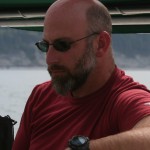
After leaving the dock at FHL we headed strait to our anchoring area, which was a gorgeous place called Griffin Bay. On the way to Griffin Bay we had very little wind but we got to put up the schreecher, the very front sail that is used primarily in low wind conditions, and everyone got a turn at the helm. While under sail we saw a few proposes, an otter and a Rhinoceros Auklet (a very cool seabird that develops a ‘horn’ on its beak in the spring). After anchoring, a very loud experience, we ate dinner accompanied by the call of a Loon. We eventually managed to spot and saw a Blue Heron as well.
After night fell we were still exploring the boat and saw some sparkling in the water off the bow of the ship. Scott told us it was bioluminescent plankton. We tried to get them to bioluminescence more by dangling a rope through the trampoline (the net on the bow of the boat) into the water the but the noise it made when we moved it through the net was echoing around the boat so Scott gave us the boathook to use instead. That made them light up really well!
You could see them really far down, they kind of look like tiny fireflies. Very cool! We are planning on going to Neah Bay tomorrow to repair the hydrophone.
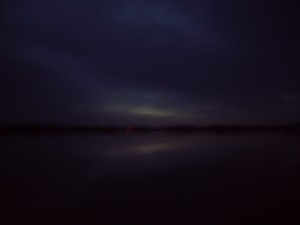
4/19
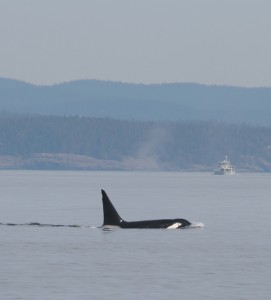
T87
Today we headed out for Neah bay at 7:00. Toward the end of breakfast Kathryn spotted some transient orcas! We got to run along side of them for the next 6 hours!
We took turns taking pictures with the zoom lens for IDs. I decided to try and look through the pictures and try to figure out which Transients they were. After some scrutiny I figured out that the male that we saw was a Transient named T87. I further confirmed this after ID-ing his sister T90b. It was very cool!
We followed the orcas down to Admiralty Inlet so we decided to dock at Fort Warden State Park in Port Townsend next to the Marine Science Center. We met the head of the Marine Science Center as well as the four very nice AmeriCorps women who work there and they let us go inside after hours and play in the touch tanks, which was a lot of fun.
4/20
Today was a very odd day. We decided to head back up to the islands and do a calibration type test for a project Jason, Scott, Val and a few others are doing before the instillation of the tidal turbines in Admiralty Inlet.
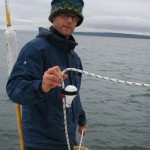
The light bulb deployment line.
We needed to put six light bulbs 10 meters apart on a rope, deploy it vertically in the water and drop a weight from the top causing each of the light bulbs to implode in turn while hydrophones recorded it from 100 m, 200m, and 400m. It sounds easy but in reality is full of logistic problems, which Libby Scott and I found while deploying the light bulb line from the inflatable dingy, affectionately named Gatito, in the middle of Admiralty Inlet while the 4 foot waves rocked us about.
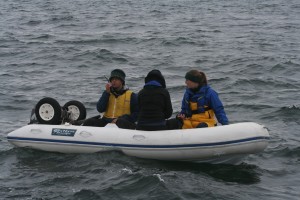
- Scott with the hat, Me in the black and Libby in the blue jacket.
We never got more than the first two light bulbs to break in about four hours of trying! We kept adjusting our attachment and weight deployment methods until the radio ran out of battery and then Scott’s telephone got too cumbersome to use. Welcome to field science!
By the time we got back to the boat we realized that with the wind, currents and time we wouldn’t be able to make it back to the islands before dark, so we decided to dock at the main harbor in Port Townsend. It was full of sailboats and the wind through the rigging made a wonderful sound like bells and chimes. It was beautiful!
4/21
We started early today, casting off at about 7:00. Horace and I were in charge of breakfast for that day so we were already up. The weather had turned foul during the night and after about 20 minuets out of the Harbor we realized that the winds were too strong, gusting to about 35 knots, and we wouldn’t be able to make it back to the islands. The seas were very choppy and because I was in the cabin cleaning up after breakfast I got pretty queasy. It wasn’t fun but at least I didn’t throw-up.
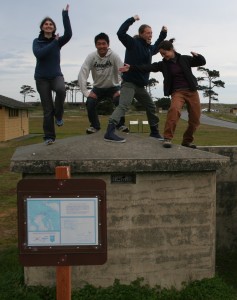
- Me, Horace, Libby and Kathryn playing at Fort Ward
We quickly turned around and ended up docking at Fort Warden for the second time in three days. It was actually a good thing too because we had a chance to accomplish some things we hadn’t gotten around to yet.
First we got to learn the names of the different parts of the boat. It was a lot of fun. I enjoyed it primarily because not only do almost all of the names make sense, but now I can respond properly to Todd’s requests.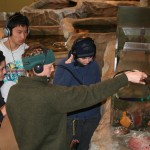
Next, since we hadn’t listened to Libby’s hydrophone yet, we got to stick it into the Marine Science Center tanks to see if any of the creatures were making any noise. We were disappointed at how quiet they were. After that we stuck it through the floor to listen to the ocean. It was a good thing we did because there were some technical problems with the recorder, but we got them fixed pretty quick.
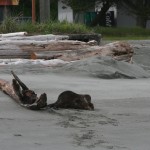 While we were in the Science Center there were a pair of otters which were mating in front of the boat and on the beach. We could hear them all the way from inside the building. It was pretty wild.
While we were in the Science Center there were a pair of otters which were mating in front of the boat and on the beach. We could hear them all the way from inside the building. It was pretty wild.
After that Scott took us to the Marine Museum and let us explore a bit before he taught us all about rocks and the geography of the area. He took us to the point down by the bunkers and we each tried to find some of the types of rocks he mentioned, igneous sedimentary and metamorphic. We had to smash some of the rocks open to get a better idea of what they were, which was very fun. Afterwards we threw an orange in the ocean to figure out which way the tide was going.
It was a very relaxing day.
4/22
Jason had to leave the boat at 5:30am to get back up to Friday Harbor to give a talk on some of the projects he is doing.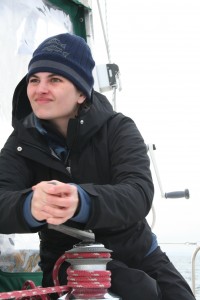
We left Fort Warden for Snug Harbor, at the North end of San Juan Island, around 9:00. On the way there the weather was perfect weather for sailing so Todd taught us how to raise and lower the mainsail and we got to do some sailing. It was a lot of fun even during the beginning when everyone was feeling a bit queasy.
We made great time and got to the head of Snug Harbor earlier than expected so we were able to do a plankton tow. We found some very cool critters, including a long translucent worm, some baby jellyfish and a few other larger predators.
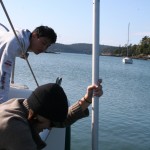
Horace and Kathryn manning the camera
After getting into the harbor, and finding out that the Beam Reach mooring was in fact gone, we decided to search for it. We used the very cool SplashCam, which is an underwater camera, to search the bottom for the anchors. While searching the bottom with the SplashCam we got to see a lot of seaweed and one crab, which startled everyone into a fit of laughter. It was a lot of fun! We never did find the mooring but since we didn’t see any eelgrass, which is important habitat and rarer than it should be, we decided to drop anchor. After we brought the camera up and ate dinner, Scott went a shore to bring some things to Val and contact Jason, who hadn’t returned to the boat or contacted us yet. We watched the sunset and after it had gotten dark we got a call from Scott saying that his sister, Laura, had given birth to a healthy son named Tennessee Viers Martine and that he was staying the night at his parent’s. Laura’s new baby is super adorable by the way!
4/23
Jason and Scott came aboard after breakfast and we decided to head down to Lime Kiln to try and find one of the hydrophones that has been lost over the years. On the way down there were perfect conditions for sailing so we got some practice in for the race we were contemplating joining the next day. We all got to man the helm as well as pull and release the Jib sheets. Kathryn and I hoisted the mainsail, not as easy as people make it look, and I got to release it.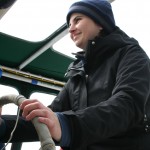
When we got to Lime Kiln we deployed the SplashCam and got an amazing look at the various sea stars, clams, sea urchins, sea cucumbers, seaweed and fish that we ran across. Unfortunately the awesomeness ended when the screen went blank and Scott shouted for Todd to stop the engine. The cord had gotten wrapped around the Starboard engine and damaged in a few areas.
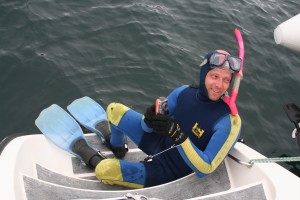 We couldn’t get the cord unwrapped from the boat, so Scott got into his wetsuit and snorkeling mask and had to dive in to un wrap it manually! A long time later, maybe 30 min to an hour, Scott unwrapped all of the cord and we were able to see the damage. It wasn’t too bad but damaged enough that they will probably have to splice the line. On our way back up to Snug Harbor we deployed the blue 4 hydrophone array as well as Libby’s hydrophone for practice. Everything went smoothly.
We couldn’t get the cord unwrapped from the boat, so Scott got into his wetsuit and snorkeling mask and had to dive in to un wrap it manually! A long time later, maybe 30 min to an hour, Scott unwrapped all of the cord and we were able to see the damage. It wasn’t too bad but damaged enough that they will probably have to splice the line. On our way back up to Snug Harbor we deployed the blue 4 hydrophone array as well as Libby’s hydrophone for practice. Everything went smoothly.
When we got back to Snug Harbor Scott and Jason went out in Gatito so Scott could snorkel to try and find the mooring anchors or ball. They were unfruitful. While they were doing that we all learned how to use a pressure cooker from Todd. It was very exciting!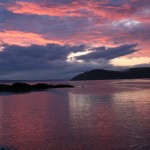
4/24
Today we started out at about 9:00 so we could get readings for the temperature, salinity and dissolved oxygen every 10 meters for 100 meters of the water that we did the plankton tow in a few days prior, before the race started at 11:00.
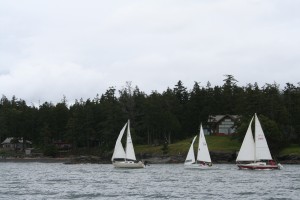 We participated in two of the races. It was a blast. During the first race we couldn’t get around the first checkpoint because our boat was too big to catch the little wind that came around the point the buoy was behind. But we did well after that.
We participated in two of the races. It was a blast. During the first race we couldn’t get around the first checkpoint because our boat was too big to catch the little wind that came around the point the buoy was behind. But we did well after that.
During the second race we were doing very well at the beginning, but one of the other sailors got stuck on some rocks so we stayed it the area until he got free. Instead of finishing the race, since we were already going the correct direction, we decided to head up to Roche Harbor to pump the holding tank (sewage) before going up to Jones Island just Northeast of San Juan Island.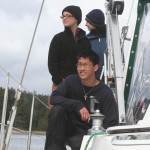
Jones Island is a gorgeous area! We got to learn how to tie to a mooring, but when someone left we moved to the dock so we could use the land heads. Before dinner, and the move to the dock, Todd showed us some knots we need to know. We learned the square knot, the bowline, the clove hitch, the girth hitch, the truckers hitch and a few others I don’t remember the names of. It was a lot of fun!
Libby Kathryn and I went for a walk and after playing on the West side of Jones Island heard from a couple that they had seen a pod of at least 12 orcas not 10 minuets prior that were traveling south past he point of Jones. We kept watch for a while but never spotted them. It was a really fun night.
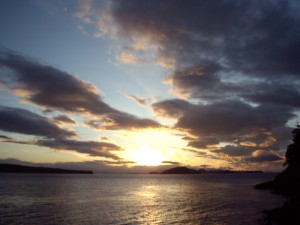
4/25
Today we left early, got to Friday Harbor Labs around 9:00 and managed to clean down the boat in about and hour. Then we waved goodbye to Todd and went back to S1 for the next 4 days.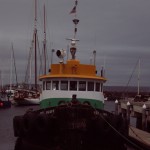 (Gato Verde translates as Green Cat)
(Gato Verde translates as Green Cat)
^_^
Read More
Snug Harbor to Jones Island (North side)
We practiced deploying our hydrophones again today, this time during a mock/surprise whale encounter timed by Jason’s watch. Hopefully we will get quicker as the probability of seeing the Southern Residents increases. We were also able to deploy the CT (Conductivity/Temperature) probe down to 100 meters, meaning that Scott Veirs graced us with some sea shanties while hauling the cable. The most exciting part of the day was not very science related, but a chance to test and strengthen our sailing skills in a friendly competition with a local sailing group. What a lovely day! Tonight we are docked at Jones Island and will have a chance to wander around and enjoy the scenery.
Read More
Snug Harbor to Snug Harbor
We woke to a very quiet boat this morning since two of our crew, Jason and Scott, were on land. We picked them up and decided to head down to Line Kiln to try and find the missing hydrophones with the SplashCam. On the way we hit perfect sailing weather and got some sailing practice in preparation for the race tomorrow. When we got to Lime Kiln we deployed the camera and all was going great for about 20 minuets until the cord got caught on the starboard propeller and got damaged. Since it was caught pretty good, Scott had to dive down and unwrap it manually! He managed to successfully unwrap the cable. Then we decided to get some practice deploying the hydrophones. First we deployed the blue 4-hydrophone array, which I call Blueberry. That went smoothly and we got to record around the lighthouse to test if the lighthouse array is getting interference from the lighthouse or from something in the water. After we brought Blueberry back on to the ship we deployed the flat-frequency-response hydrophone, “Hiphone”, which Libby will be using for her project. We tested it at a few different speeds to see what towing speed has the least interference. We had some animal sightings, including an otter and a harbor seal.
Read More
Port Townsend to Snug Harbor
After giving our regards to the mating river otters of Port Townsend, we motor sailed northwards practicing at the helm and sighting two puffins as we passed False Bay. Before entering Snug Harbor we tried out the YSI probe and the plankton net, devising a protocol for monitoring basic physical and biological oceanographic conditions where the southern residents focus their summertime attention. Finally, we tested out the Splashcam video camera while beginning our Earth Day project: searching for our mooring ball which was sunk by growth last winter. The camera wasn’t very useful unless it was resting on the bottom, but we’re hopeful that we can locate the old ball and replace it with our new (more buoyant) one so that we can minimize our impact on the Harbor, a place that we know is swept nearly bare of eel grass by anchor chains.
Read More
Port Townsend to Port Townsend
(Boat Haven to Marine Science Center)
We raised anchor early today and were out of Boat Haven by 0715. Capt. Todd had anticipated strong winds, but when we got out in open water, we realized the 35 knot gusts weren’t worth the risk. We turned back toward Port Townsend around 0800 and tied up at the dock by the Port Townsend Marine Science Center.
At 1400 we went to the science center to test the Flip videocamera in its underwater housing. We took footage of a juvenile octopus as we knocked on the glass, trying to get an idea of how sound from the outside affects the octopus’s acoustic environment.
We also used a hydrophone to listen to sounds inside several of the center’s tanks to see whether or not the organisms were making any sounds. We deployed the same hydrophone into the ocean but realized we couldn’t hear anything when we used the Marantz (which,we later realized, was due to a faulty XLR to quarter inch cable).
Read More
Port Townsend to Port Townsend
(Marine Science Center to Boat Haven)
Departed Port Townsend after breakfast at about 8:00. Arriving out at Admiralty Inlet, both Jason and Scott performed their SnowPud experiment with lightbulbs and a hydrophone array. Scott, along with Nora and Libby, set out on the small dinghy, the Gatito. Taping lightbulbs at 10 meters apart from each other on a marked rope, it was lowered into to the water with the help of a weight. A hydrophone array was lowered on the starboard side of the Gato Verde, where Jason was stationed to prepare to record. A shackle with a weight would be sent down the lightbulbed rope, hoping to break all the lightbulbs. The sounds would be recorded by the hydrophone array at 100m, 200m, and 400m distance. Being in Admiralty Inlet made it difficult to perform exact distances, plus some lightbulbs did not break. Recordings were still taken. Docking at Boat Haven, Port Townsend Marina, we pumped out and charged the boat.
Read More
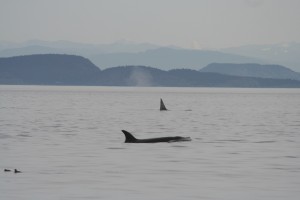
Transients traversing the San Juans
Griffin Bay to Port Townsend:
We departed San Juan Island with the intention of sailing all the way to Neah Bay, but shortly after finishing our chores, Kathryn said the word everyone was hoping to hear “whale off Starboard!”
We were able to identify Transient male #87, and think we know some of the females as well. First the male was swimming with four others, then two groups converged for a bit of exciting times, and departed once again. Overall, the transient group seemed bound to the east/southeast. They led us past Smith Island and all the way into Admiralty Inlet.
Once we were joined by two whale-watching boats the whales seemed to lighten up and give us a show. We saw plenty of tail slaps and harmonious movements, and even a spy hop and peck slap were seen. Great first day of being on the boat! The sun was out for most of the day, and the wind was gentle so we did not put up the sails.
We set up and tested the new hydrophone array. All 4 elements work and we were able to hear nearby boats, but the transients made no audible sounds during the hour or so that the array was in the water.
Read More


























 Twitter
Twitter LinkedIn
LinkedIn Facebook
Facebook